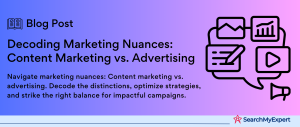Market Research in the Advertising Industry
Defining Market Research and Its Significance
Market research stands as a critical cornerstone in the realm of advertising. It’s the compass that guides advertisers through the complex maze of consumer preferences, market trends, and competitive landscapes. By definition, market research encompasses the process of gathering, analyzing, and interpreting information about a market, including products and services, target customers, and competitors. This systematic approach helps businesses make informed decisions about their advertising strategies and campaigns.
In the advertising industry, market research is not just important; it’s indispensable. It serves as the bedrock upon which successful advertising campaigns are built. Here’s why:
- Understanding Consumer Needs:
Market research unravels the mysteries of consumer needs and preferences. It sheds light on what consumers want, need, and expect from products or services. - Targeted Advertising: It enables advertisers to create tailored messages that resonate with specific audience segments. By understanding the audience, ads can be more effective and engaging.
- Competitive Edge:
In a world where competition is fierce, market research offers insights into what competitors are doing, helping businesses to stay one step ahead. - Risk Mitigation: It reduces the risks associated with advertising campaigns. By testing concepts and messages, businesses can avoid costly mistakes.
- Innovation and Trends: Market research keeps businesses in tune with the latest trends and fosters innovation in advertising strategies.
- Performance Measurement:
It aids in evaluating the effectiveness of advertising campaigns, providing data for continuous improvement.
The Benefits of Market Research for Advertising Campaigns
The perks of conducting market research for advertising campaigns are manifold. Here are some key benefits:
- Enhanced Campaign Effectiveness:
Market research ensures that advertising campaigns are built on a foundation of real, actionable insights. This leads to more effective and impactful campaigns. - Increased ROI:
With targeted campaigns that resonate with the audience, businesses can see a higher return on investment. - Customer-Centric Approach:
It facilitates a deeper understanding of customers, leading to more customer-centric advertising strategies. - Brand Development:
Through understanding market needs and gaps, businesses can develop stronger, more relevant brands. - Adaptability: Market research helps businesses adapt quickly to changing market conditions and consumer behaviors.
- Data-Driven Decisions:
It fosters a culture of making decisions based on data rather than assumptions.
Market research in advertising is not just about gathering data; it’s about gaining insights that fuel creativity, innovation, and effectiveness in campaigns. It’s about understanding the heartbeat of the market and aligning advertising efforts with the rhythms of consumer desires and market dynamics. As the advertising landscape continues to evolve, the role of market research becomes ever more pivotal in crafting campaigns that not only capture attention but also drive meaningful results.
Understanding the Target Audience
Gathering Consumer Insights
Understanding the target audience is the linchpin of any successful advertising campaign. It involves delving deep into consumer demographics, interests, and behaviors. This process begins with data collection, employing various methods such as surveys, focus groups, and social media analysis. The goal is to paint a comprehensive picture of who the consumers are, what they value, and how they interact with brands.
Key Areas of Focus:
- Demographics:
Age, gender, income level, education, and occupation. - Interests:
Hobbies, lifestyle choices, and entertainment preferences. - Behaviors: Purchasing habits, brand interactions, and online activities.
Identifying Target Audience Segments
The next step is segmenting the audience into distinct groups based on shared characteristics. This segmentation allows advertisers to tailor their messages more effectively. Common segmentation criteria include:
- Psychographics: Personality traits, values, attitudes, and lifestyles.
- Geographics: Location-based segmentation such as urban, suburban, or rural areas.
- Behavioral:
Based on consumer interactions with products or brands.
Developing Buyer Personas
Buyer personas are fictional representations of ideal customers based on real data and educated speculation about demographics, behaviors, and motivations. They help advertisers visualize and understand their audience better. Creating personas involves:
- Combining Insights: Integrating demographic, psychographic, and behavioral data.
- Storytelling:
Giving each persona a name, background, and narrative. - Goal Identification:
Understanding what drives each persona and their pain points.
Analyzing Consumer Preferences, Attitudes, and Pain Points
The final piece of understanding the target audience is analyzing their preferences, attitudes, and pain points. This involves:
- Preference Analysis: Understanding what consumers prefer in terms of products, services, and brand experiences.
- Attitude Assessment: Gauging how consumers feel about various aspects of the market and advertising messages.
- Pain Point Identification: Recognizing the problems or challenges that consumers face, which the product or service can solve.
By integrating these insights, advertisers can create campaigns that are not just seen but felt by the audience. It’s about striking a chord, resonating on a personal level, and building a connection that goes beyond the superficial. In the end, understanding the target audience is about empathy – putting yourself in the consumer’s shoes and seeing the world from their perspective.
Identifying Market Trends and Opportunities
Staying Ahead with Industry Trends and Competitor Analysis
In the dynamic world of advertising, being a trendsetter or a quick adapter is key to success. Keeping a finger on the pulse of industry trends, competitor activities, and market shifts is crucial. This vigilant approach allows businesses to anticipate changes and adapt their strategies accordingly.
Key Components:
- Market Trends Analysis: This involves monitoring emerging patterns in consumer behavior, technological advancements, and changes in market dynamics. Staying informed about industry trends helps in predicting future market movements.
- Competitor Activity Monitoring:
Understanding what competitors are doing – their new product launches, marketing campaigns, or strategic shifts – provides invaluable insights. It helps in identifying what works in the market and what doesn’t. - Market Shifts: Being aware of economic, social, and political shifts that can impact the market. This foresight aids in preparing for potential challenges and leveraging new opportunities.
Uncovering Market Gaps and Opportunities
The key to innovation in advertising is not just following trends but also identifying gaps in the market. These gaps represent unmet consumer needs or areas where current products or services fall short. By identifying these gaps, businesses can uncover opportunities for new products or services that can give them a competitive edge.
Steps to Identify Market Gaps:
- Consumer Feedback Analysis: Listening to customer feedback can reveal unaddressed needs or dissatisfaction with current market offerings.
- Competitive Analysis: Assessing the offerings of competitors can highlight areas where the market is underserved.
- Market Research:
Conducting thorough market research helps in identifying trends that are not yet fully exploited by competitors.
Analyzing Competitor Strengths and Weaknesses
A comprehensive analysis of competitors’ strengths, weaknesses, and marketing strategies provides a strategic advantage. It involves:
- Strengths and Weaknesses Assessment: Evaluating what competitors do well and where they fall short. This insight can guide businesses in refining their own strategies.
- Marketing Strategy Analysis: Studying competitors’ advertising messages, channels used, and audience engagement tactics. It helps in understanding what resonates with the audience and identifying best practices.
Optimizing Advertising Messages and Creative
Developing Resonant Messaging
The essence of impactful advertising lies in the message. Crafting messaging that speaks directly to the target audience’s needs, desires, and values is critical. This involves understanding the audience deeply and translating that understanding into compelling messages.
Key Strategies:
- Message Tailoring: Customizing messages to align with different audience segments. Personalization makes messages more relevant and engaging.
- Emotional Connection:
Creating messages that evoke emotions, as emotional appeals often have a stronger impact than purely informational content.
Crafting Compelling Ad Copy and Visuals
The ad copy and visuals are the vehicles that carry the message to the audience. They need to be attention-grabbing, memorable, and, most importantly, reflective of the audience’s preferences and values.
Elements of Effective Ad Creatives:
- Engaging Copy: Writing copy that is clear, concise, and compelling. It should highlight the benefits of the product or service in a way that resonates with the audience.
- Visual Appeal: Designing visuals that are eye-catching and relevant to the message. The use of colors, images, and graphics should align with the brand identity and appeal to the target audience.
Testing Ad Variations
The final step in optimizing advertising messages and creatives is testing. This involves creating different variations of ads and measuring their effectiveness.
Testing Methods:
- A/B Testing:
Comparing two versions of an ad to see which performs better. This can involve testing different headlines, images, or calls to action. - Audience Feedback: Gathering feedback from the target audience on different ad versions. This can provide direct insights into their preferences.
- Performance Metrics Analysis:
Analyzing key performance indicators like click-through rates, conversion rates, and engagement levels to determine the most effective ad variations.
By continuously testing and refining, businesses can ensure that their advertising messages and creatives are as effective as possible, leading to better engagement, higher conversion rates, and ultimately, more successful advertising campaigns.
Selecting the Right Media Channels and Platforms
Identifying Suitable Media Channels for Target Audience Reach
Selecting the right media channels is a pivotal step in ensuring that your advertising message reaches the intended audience effectively. The goal is to identify where your target audience spends their time and how they consume media. This selection should be a strategic decision based on several factors.
Considerations for Channel Selection:
- Audience Demographics: Understanding the age, gender, income level, and other demographic factors of your target audience helps in selecting channels that they are most likely to use.
- Media Consumption Habits: Different audiences have different media consumption patterns. Younger demographics might be more reachable through digital and social media, while older demographics might be more responsive to traditional media like television or print.
- Budget Constraints: The cost of advertising on various channels varies significantly. It’s important to choose channels that fit within your advertising budget while still reaching a substantial portion of your target audience.
- Campaign Goals: The choice of media channels should align with the campaign’s objectives, whether it’s brand awareness, lead generation, or direct sales.
Experimenting with Media Channels and Platforms
Experimentation is key in the dynamic landscape of media. Trying different channels and platforms can reveal new opportunities and insights into audience preferences.
Strategies for Experimentation:
- Multichannel Approach: Using a combination of different channels can help in reaching a broader audience and provides the opportunity to see which channels perform best.
- Pilot Campaigns:
Running small-scale pilot campaigns on potential new channels can gauge their effectiveness without committing a large portion of the budget. - Analytics and Feedback:
Regularly analyze campaign performance and gather audience feedback to continuously refine the choice of channels.
Evaluating Advertising Campaign Effectiveness
Tracking Key Performance Indicators (KPIs)
Evaluating the effectiveness of an advertising campaign is essential for understanding its impact and identifying areas for improvement. This involves tracking various KPIs that align with the campaign’s objectives.
Important KPIs:
- Brand Awareness:
Measures the extent to which consumers are familiar with the brand. This can be tracked through surveys, social media mentions, and search query volumes. - Engagement: Involves tracking interactions such as likes, shares, comments, and time spent on the ad or website.
- Conversions: The most crucial metric for many campaigns, conversions indicate the number of users who took the desired action, like making a purchase or signing up for a newsletter.
Conducting Surveys, Focus Groups, and A/B Testing
Beyond quantitative data, qualitative insights are vital for a comprehensive understanding of campaign effectiveness.
Methods for Qualitative Insights:
- Surveys:
Collecting feedback directly from the target audience about their perceptions and reactions to the campaign. - Focus Groups:
Discussing the campaign with small groups of target audience members can provide deep insights into their attitudes and perceptions. - A/B Testing: Comparing two versions of a campaign element (like an ad copy or landing page) to see which performs better in terms of engagement and conversions.
Analyzing Campaign Results and Improvement Areas
The final step involves a thorough analysis of the campaign results. This should lead to actionable insights for future campaigns.
Analysis Approach:
- Performance Review: Evaluate if the campaign met its set objectives and KPIs.
- Identifying Success Factors: Understand what elements of the campaign worked well.
- Recognizing Areas for Improvement: Identify aspects that did not perform as expected and require modification.
- Adapting Strategies: Use the insights gained to adapt and improve future advertising strategies.
Refining Advertising Strategies Based on Market Research
Continuous Market Research for Informed Advertising
In the ever-evolving world of advertising, staying static is not an option. Continuously gathering market research insights is crucial for keeping advertising strategies relevant and effective. This involves an ongoing process of collecting and analyzing data about market trends, consumer behavior, and competitive activities.
Key Actions for Continuous Market Research:
- Regular Data Collection: Implementing consistent mechanisms for collecting market data, such as surveys, web analytics, social media monitoring, and industry reports.
- Consumer Feedback Loop: Establishing channels for continuous consumer feedback to understand changing preferences and experiences.
- Competitor Monitoring: Keeping a close watch on competitors’ strategies and market moves to identify shifts in the competitive landscape.
Adapting and Refining Strategies Based on New Data
The true value of market research lies in its application. Adapting and refining advertising strategies based on new data ensures that campaigns remain effective and relevant.
Strategies for Adaptation:
- Data-Driven Decision Making: Making changes to advertising strategies based on concrete data insights rather than assumptions or gut feelings.
- Trend Analysis: Identifying emerging trends from the market research and incorporating them into advertising strategies.
- Segmentation and Personalization:
Using insights to segment the audience more accurately and personalize advertising messages to resonate with different groups.
Optimizing Campaigns for Maximum ROI
Optimization is the key to maximizing the return on investment (ROI) from advertising campaigns. This involves tweaking various elements of the campaign based on market research insights to achieve the best results.
Optimization Techniques:
- Targeting Efficiency:
Refining target audience profiles to ensure that advertising efforts are focused on the most receptive segments. - Message Refinement:
Continuously testing and improving the messaging and creative elements of the campaigns to increase engagement and conversions. - Channel Optimization: Allocating budgets to the most effective channels and platforms as identified by ongoing research.
- Performance Tracking:
Regularly measuring campaign performance against set KPIs and adjusting strategies accordingly.
Conclusion
In conclusion, refining advertising strategies based on continuous market research is a dynamic and ongoing process. It involves staying alert to market changes, being adaptable in strategy implementation, and consistently seeking optimization opportunities to ensure maximum impact and ROI from advertising campaigns. This approach not only enhances the effectiveness of individual campaigns but also contributes to the long-term success and competitiveness of the brand in the marketplace.
Turn your vision into reality with our expert Advertising Services.
Table of Contents
Toggle






